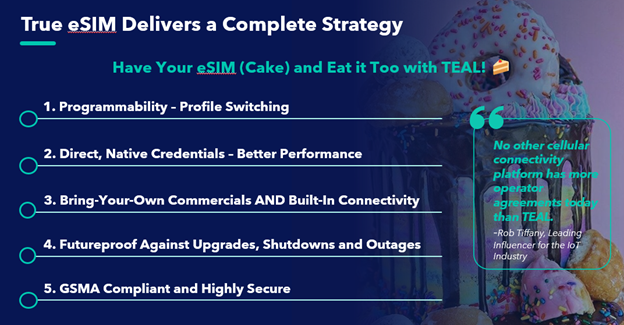Understanding the Different Types of eSIM Technology and Providers

Are you looking for a comprehensive guide to eSIM technology and providers? You’ve come to the right place! eSIMs are revolutionizing the way we manage our mobile connections and with more providers and carriers offering eSIM solutions, it’s important to understand the differences between the various types of eSIM and what the benefits of each can offer your business. Keep reading to learn about different providers, their features, and how they can help your business flourish!
Assessing the eSIM Choices
MNO eSIM
Mobile network operator (MNO) eSIMs tend to be tied back to their own network and reliant on the technology generation available at the time of deployment. They usually lack the ability to switch providers nationally and international connectivity likely comes through the operator’s standard inter-carrier roaming agreements. The latter can prove expensive and is reliant on the supplier in question having stable, favorable relationships, or in some cases any relationship, in whichever country the device is set to be used in. These relationships usually change over time. Within the operator’s home market, devices have a single point of failure, potentially making them vulnerable to outages or if networks are sunsetted. There is not typically a backup domestic network. Although cost-efficient for access to their own network, MNO supplied eSIM is essentially a direct replacement for a physical SIM and offers a similar level of inflexible access. For these reasons, an MNO offered eSIM solution is most viable for a planned single network deployment.
MVNO eSIM
Getting eSIM connectivity from a Mobile Virtual Network Operator (MVNO) has many of the same issues as an operator, though usually with degraded performance as MVNO users are often deprioritized on the serving radio networks while also typically offering a smaller scale of back-end infrastructure. In terms of connectivity options, these can be limited especially in their host operator’s domestic market and actual network availability, performance, and sunsetting of technology is out of their hands. When relying on this type of provider, there is also risk with the agreement they have with their host provider which could change over time. MVNOs commonly cannot access elements which are the greatest advantages of eSIM. This is because they have: a reliance on third party contract eSIM solutions, a reliance on roaming (often through agreements provided by their host operator); no support for private networks; little control or flexibility over pricing; and an inability to offer the lowest latency in the market. Most MVNO players offering eSIM capabilities today are renting or leasing their eSIM platform, which limits flexibility and fails to yield some of the true benefits that the technology offers.
Traditional SIM Providers
Several suppliers of physical SIM cards also supply eSIM solutions. Think the likes of Idemia, Thales, VALID, etc. When using SIM technology specialists, enterprises will often find the eSIM doesn’t come with any of the network profiles required for a fast launch and companies will be essentially paying to build their own eSIM solution. They provide neither the connectivity management platform nor pre-integrated networks. Although this can work for companies with huge scale, budget, and influence, it is not ideal for most enterprises given the costs and timelines associated with arranging carrier agreements and the requirement to foot the bill for integration projects.

You Can Have Your eSIM and Eat it Too!
“True” eSIM

There are a limited number of “true” eSIM solutions in the market that are ready for global enterprise deployments and full eSIM optionality at scale. Teal, for example, has its own eSIM platform, runs its own source code, and is not reliant on third parties for integration with the ability to preconfigure with a range of carriers. The system uses a crowdsourcing model, creating a network-as-an-app style system. If a carrier profile is requested that is not already integrated into the Teal system, they can integrate it into its platform for free on behalf of the IoT enterprise. This is because “true” eSIM platforms like Teal are serious about growing a collaborative 800+ carrier eSIM technology platform. Imagine accessing thousands of network configurations in a network “app store” when you can just select the one that fits your solution and you’ll then be directly connected to it, eliminating roaming completely. 
The IoT ecosystem is growing rapidly and with it comes greater demand for flexibility and control within eSIM technology. While traditional MNO eSIMs provide a cost-efficient service within their own network, the drawbacks of inter-carrier roaming agreements can make it inflexible when used in multiple countries. MVNO and SIM provider eSIMs can offer flexibility, but at the cost of performance and complexity of implementation. At Teal, we believe that our eSIM technology provides the best possible solution to meet the evolving needs of enterprises. It offers the full benefits of eSIM technology, including flexibility and control, security, and easy management through a dedicated portal.
Don’t make the mistake of choosing the wrong eSIM solution for your business.
If you’re evaluating eSIM technology, be sure to download the GSMA’s free eSIM Buyer’s Guide for Enterprise and get the information your business needs to select the right platform to fit your needs.
Download for free here!
Recent Posts
TEAL’s Network Orchestration Service (NOS) is Changing Cellular Connectivity
Teal Communications Staff2025-07-15T19:59:45+00:00
How TEAL’s eSIM Technology is Shaping the Future of Drone AAM Policy Under FAA Part 108
Teal Communications Staff2025-07-08T16:48:15+00:00
Empowering Freedom, Independence, and Control Through TEAL’s Network Orchestration Service (NOS)
Teal Communications Staff2025-07-03T16:40:46+00:00




